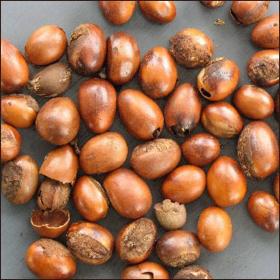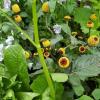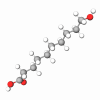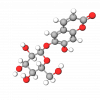The shea tree is a native of western Africa. Afro-Egyptian medical and beauty history is full of references to its butter. For example, Cleopatra was purported to have used shea butter preparations on her skin regularly. The Karite tree is revered in Africa, where the funeral beds of African kings are carved from an old shea tree.
Shea Butter (Butyrospermum Parkii Butter) is an off-white semi-solid fat, with no or faint odor derived from Shea tree* kernels. It is soluble in alcohol or oils and insoluble in water. Shea butter is edible vegetable oil and a constituent of the choice of numerous leave-on skin, scalp, and hair care formulations. It is a semi-solid, buttery oil It is safe and does not irritate or sensitize the skin. This edible butter became one of the front-runners in the skincare industry due to its outstanding moisturizing performance, anti-inflammatory, and antioxidant properties. The major part of Shea butter is vegetable fat, which blends with the skin's natural lipid compartments very well and exerts a superb occlusive effect. It traps water molecules inside the top layer of the skin and prevents epidermis dehydration and scaling. This is why it is widely used to treat various skin dryness-related disorders such as dermatitis, eczema, and psoriasis. In addition, Shea butter lubricates the skin, making it look plump, bright, and velvety smooth.
This exclusive butter is full of active ingredients. It contains vitamins A and E (tocopherols), allantoin, phenolic compounds (catechins and quercetin), sterols, and triterpenes. All of these ingredients combat skin aging by showcasing antioxidant and anti-inflammatory properties. It is widely accepted that the skin's significant adversaries are inflammation and photoaging (UV irradiation of the sun). These processes have a substantial contribution to collagen and elastin degradation. Eventually, they lead to the destruction of skin scaffolding and make it sagged and wrinkled. Active ingredients of Shea butter reduce skin inflammation, redness, and swelling. They also protect the skin from sunburn (SPF 3-4) by absorbing some sunlight and combating harmful particles caused by the sun's UV light.
Due to its rich composition, safety, and soothing impact, this exceptional oil is a valuable ingredient in highly efficient beauty formulations. Butyrospermum Parkii Butter is used in lotions, creams, sun care and after-sun products, facial moisturizers, body butter, ointments, and lip balms.* It is also called Butyrospermum Parkii or Vitellania Paradoxa or Karite tree.
Ingredients
Ingredient products
Ingredient history
Shea Butter has been prized for centuries in Africa because of its fantastic moisturizing, healing, and protective properties. An abundant natural resource derived from the fruit of the indigenous Shea (Karite) tree, shea butter is found in locally made soaps and applied directly to skin and hair by women throughout central Africa to provide protection from the harsh African environment.
Over time, this traditional treatment has found its way from the African Savannah into local drug stores worldwide, receiving a particularly warm reception in Europe and North America. Specifically, in the ethnic market, shea butter has been widely used in various skin and hair products, and this practice continues today.
Products incorporating shea butter range from facial moisturizers to foot creams and lotions, suncare, bath soaps, lip balms, and hair conditioners. No matter what the product, refined Shea Butter is an excellent choice that works beautifully.
About tree and fruit
The Shea tree is an African tropical tree growing anywhere from 40 to 65 feet in height. The branches are short, and the bark is greyish on the exterior and red on the inside.Flowering begins in January through March, and the flowers themselves are clustered together at the extremity of the stem. The fruit is a berry that looks like a large plum and turns yellowy-green upon reaching maturity.
The almond or seed within the fruit has 45 to 55 % fat/oil content.
Production
Traditionally, shea butter is obtained by removing the fruit pulp by fermentation, and then the seed is washed and sorted. It imported from Africa does not undergo any further transformation, and being rich in unsaturated fatty acids, it can develop a strongish odor quickly.
Shea butter can be further refined to ensure further stability over time.
Uses
Shea butter melts at body temperature and is most effective at "cell regeneration," meaning it is most efficient at combatting the ravages of the aging process as well as softening and moisturizing the skin. As a result, it is often added to massage and moisturizing creams as well as makeup, adding shine to lipstick.What are the benefits of Shea butter?
Shea butter contains natural anti-inflammatory compounds. The effectiveness of shea butter’s anti-inflammatory action is confirmed by its’ traditional uses for arthritis, rheumatism, bruising, and sprains. In addition, Shea butter possesses remarkable properties. Clinical trials have shown that shea butter really will reduce wrinkles in most individuals while helping with skin conditions like dermatitis, sunburn, and scarring. Shea butter is high in fatty acids like stearic and oleic acid, which are very helpful in moisturizing the skin and improving skin elasticity.










